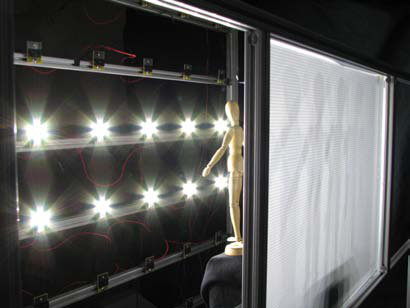TR2008-085
Shield Fields: Modeling and Capturing 3D Occluders
-
- , "Shield Fields: Modeling and Capturing 3D Occluders", ACM Transactions on Graphics (TOG), Vol. 27, No. 5, December 2008.BibTeX TR2008-085 PDF
- @article{Lanman2008dec,
- author = {Lanman, D. and Raskar, R. and Agrawal, A. and Taubin, G.},
- title = {Shield Fields: Modeling and Capturing 3D Occluders},
- journal = {ACM Transactions on Graphics (TOG)},
- year = 2008,
- volume = 27,
- number = 5,
- month = dec,
- issn = {0730-0301},
- url = {https://www.merl.com/publications/TR2008-085}
- }
- , "Shield Fields: Modeling and Capturing 3D Occluders", ACM Transactions on Graphics (TOG), Vol. 27, No. 5, December 2008.
-
Research Area:

Abstract:
We describe a unified representation of occluders in light transport and photography using shield fields: the 4D attenuation function which acts on any light field incident on an occluder. Our key theoretical result is that shield field can be used to decouple the effects of occluders and incident illumination. We first describe the properties of shield fields in the frequency-domain and briefly analyze the "forward" problem of efficiently computing cast shadows. Afterwards, we apply the shield field signal-processing framework to make several new observations regarding the "inverse" problem of reconstructing 3D occluders from cast shadows-extending previous work on shape-from-silhouette and visual hull methods. From this analysis we develop the first single-camera, single-shot approach to capture visual hulls without requiring moving or programmable illumination. We analyze several competing camera designs, ultimately leading to the development of a new large-format, mask-based light field camera that exploits optimal tiled-broadband codes for light-efficient shield field capture. We conclude by presenting a detailed experimental analysis of shield field capture and 3D occluder reconstruction.
Related News & Events
-
NEWS ACM Transactions on Graphics (TOG): publication by Amit Agrawal and others Date: December 15, 2008
Where: ACM Transactions on Graphics (TOG)
Research Area: Computer VisionBrief- The article "Shield Fields: Modeling and Capturing 3D Occluders" by Lanman, D., Raskar, R., Agrawal, A. and Taubin, G. was published in ACM Transactions on Graphics (TOG).